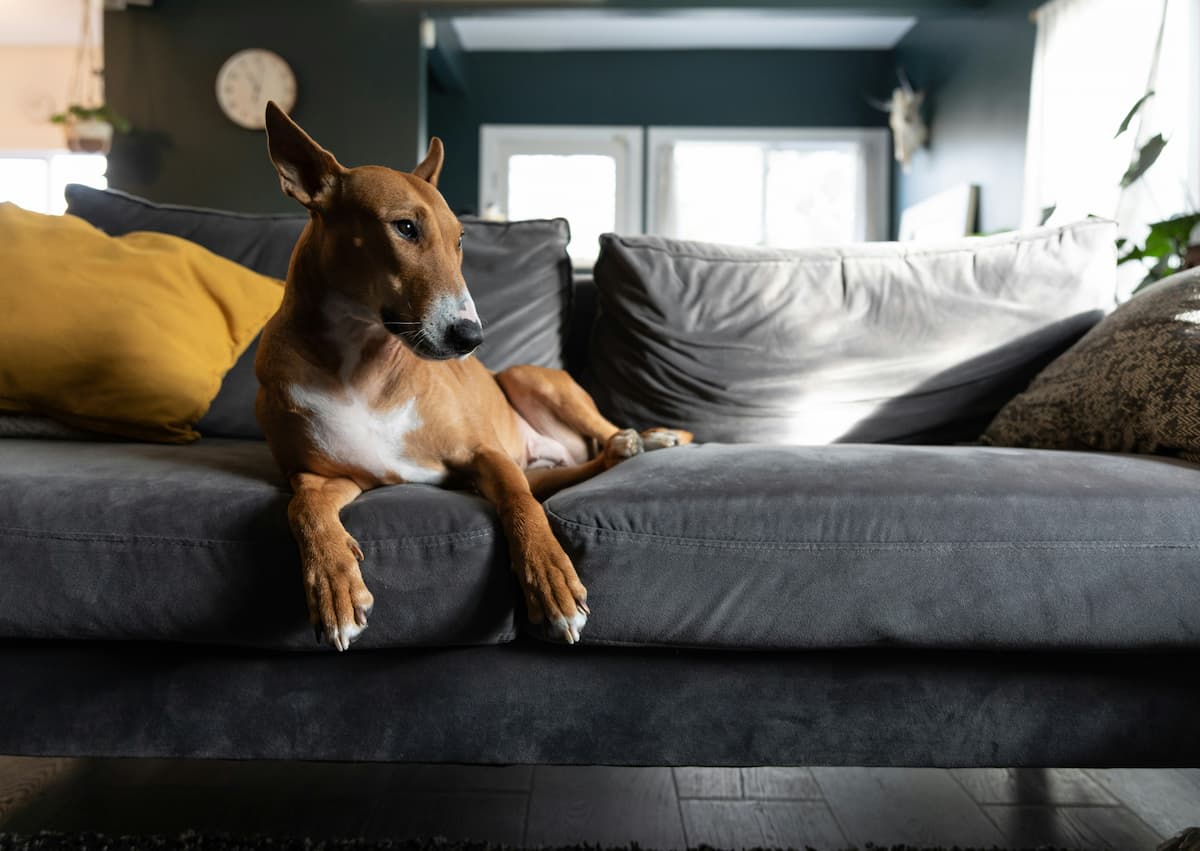Have you ever caught your dog lounging around with their front legs crossed?
While dogs are known for their playful antics and endless energy, there’s something undeniably charming about watching them strike a pose reminiscent of humans.
But have you ever wondered why they do it?
This article will explain this unusual yet adorable behavior.
Understanding the Possible Reasons behind Dogs Crossing Their Front Legs
Dogs are fascinating creatures with a multitude of behaviors that often leave us puzzled and intrigued.
One such behavior that many dog owners may have noticed is the curious habit of crossing their front legs.
While this may seem like a simple posture, it actually holds deeper meaning and can provide valuable insights into your furry friend’s state of mind.
One reason why dogs may cross their front legs is simply for comfort.
Just like humans, dogs have their preferred resting positions, and crossing their front legs can provide a sense of security and relaxation.
This posture helps them achieve a cozy and well-balanced position, allowing them to take a peaceful nap or observe their surroundings with ease.
So, next time you see your pup crossing their front legs, know that they are simply finding a comfortable and secure spot to unwind.
Another explanation behind this behavior lies in a dog’s instinctual need for warmth.
By crossing their front legs, dogs are able to curl up their body, minimizing exposed surface area and conserving heat.
This behavior is an innate survival instinct that ensures their bodies stay warm in colder temperatures.
It’s fascinating to think that even though our furry companions have adapted to living in our cozy homes, their instincts still drive them to seek warmth and comfort in their own unique ways.
Another reason dogs may cross their front legs is to maintain balance.
Dogs are incredibly agile creatures, and they have a natural knack for adjusting their body position to stay steady.
Crossing their legs actually helps them distribute their weight evenly, making it easier for them to balance on various surfaces, especially when standing on slippery or unstable ground.
It’s a smart adaptation that ensures our four-legged friends can confidently navigate their surroundings.
Lastly, crossing their front legs can also be a sign of submission or submissiveness in dogs.
When a dog feels intimidated or is trying to demonstrate that they are non-threatening, they may cross their front legs as a way to signal their vulnerability.
It’s their way of saying, “I’m not a threat, you can trust me.”
This behavior is often seen during social interactions with other dogs or when they are trying to appease their human companions.
Another interesting aspect to consider is that certain dog breeds have a natural inclination towards crossing their front legs.
For example, many small or toy breeds, such as Chihuahuas and Yorkshire Terriers, are often seen striking this pose.
It could be due to their size or their ancestors’ tendencies, but whatever the reason, it has become a unique characteristic of these breeds.
Even though it’s not exclusive to them, it’s still a charming trait that adds to their overall cuteness.
Tips to Decipher if a Dog’s Front Leg Crossings Indicate Comfort or Discomfort
Many of you have wondered about the significance of your dog crossing its legs.
Is it a sign of comfort or discomfort? Here are some tips to help you decipher what your furry friend is trying to tell you.
Observation is key! The first step in understanding why dogs cross their front legs is to observe the context in which they do it.
Look for signs of relaxation and comfort.
If your dog is in a relaxed posture and appears calm while crossing their legs, it’s likely that they are doing so out of comfort.
They might be trying to find a cozy position or simply mimicking their owner.
On the other hand, if your dog crosses their front legs while showing signs of stress or anxiety, it could indicate discomfort.
Body language speaks volumes. Dogs communicate not only through their barks and whines but also through their body language.
Pay attention to other cues your dog might be giving while crossing their front legs.
If they have a relaxed body, a wagging tail, and a content expression, it’s a good indication that they are comfortable.
However, if their body is tense, their ears are flattened, and they avoid eye contact, it’s a sign of discomfort or unease.
Remember, dogs can’t verbally communicate like we do, so it’s important to interpret their body language accurately.
Know your dog’s history. Lastly, understanding your dog’s history and personal preferences can provide valuable insight into why they might cross their front legs.
Some dogs might have learned this behavior as a form of self-soothing or as a way to cope with anxiety.
Others might have seen their canine companions or their owners do it and simply adopted the habit.
By knowing your dog’s background and individual quirks, you’ll be better equipped to decipher whether their front leg crossings indicate comfort or discomfort.
Enhancing Your Bond with Your Furry Friend through Observing and Responding to Front Leg Crossings
Observing your dog’s front leg crossings can be a great way to enhance your bond with them. It allows you to understand their body language and emotions more deeply. Just like humans, dogs use body language to communicate their feelings.
By paying attention to how your dog crosses their front legs, you can learn to decipher their emotions and respond appropriately.
For instance, if you notice your dog crossing their front legs tightly while also tucking their tail between them, it could be a sign of anxiety or fear.
On the other hand, if they casually cross their legs while lying on their side, it may indicate relaxation and contentment.
By observing and responding to these subtle cues, you can create an environment that fosters trust and helps build a stronger bond between you and your furry friend.
Here are a few tips to enhance your bond with your canine companion through observing and responding to their front leg crossings:
-
- Pay attention to their body language: Observe how your dog crosses their front legs in different situations.
Take note of any patterns or changes in their behavior.
This will help you understand their feelings and respond accordingly.
- Respond appropriately: Once you have identified the emotions behind their leg crossings, respond in a way that makes them feel safe and comfortable.
If they appear anxious, try providing a calm and soothing environment.
If they seem relaxed, join them by offering gentle pets or playtime.
- Build trust through observation: By consistently observing and responding to your dog’s body language, you will establish a deeper level of trust between you and your furry friend.
This trust is the foundation for a strong bond and will help create a harmonious relationship based on clear communication. By taking the time to understand and respond to your dog’s front leg crossings, you can strengthen your bond and create a more meaningful connection with your furry friend.
So, next time you see your dog cross their front legs, take a moment to observe, respond, and deepen that special bond you share.
FAQ
Q: So, why exactly do dogs cross their front legs?
A: Dogs cross their front legs for various reasons, but mainly it’s all about comfort and relaxation.
Believe it or not, dogs enjoy getting into cozy positions just as much as we do.
When they cross their front legs, it’s like they’re settling down for a doggy nap.
Q: Is there a specific reason why dogs might choose to cross their legs?
A: Absolutely! Sometimes, dogs cross their front legs simply because they’re sleepy.
Just like us humans, they find this position quite comfy and soothing. It’s their way of telling us, “Hey, I could use a little snooze now!” Q: Are there any health benefits to dogs crossing their front legs?
A: Well, crossing their front legs doesn’t necessarily have any direct health benefits.
However, when a dog crosses their front legs, it helps to distribute their weight more evenly, giving them a solid base and potentially reducing any strain on specific muscles or joints.
Q: Could it be a sign of anxiety or stress?
A: In some cases, yes.
Dogs might also cross their front legs as a way to cope with anxious or stressful situations.
Similar to how we might bite our nails or fidget when we’re nervous, dogs might resort to crossing their legs as a self-soothing mechanism. It’s like their own little trick to ease their worries.
Q: Is this behavior more common in certain breeds?
A: Crossing the front legs isn’t necessarily more prevalent in specific breeds; it can actually be seen across various breeds and sizes.
It’s all about individual preference and personality.
Q: Should I be concerned if my dog frequently crosses their front legs?
A: Not necessarily.
Unless your dog appears uncomfortable or displays signs of pain or discomfort while in this position, there’s usually no need to worry.
Keep in mind that dogs, just like us, have their own quirky habits and unique ways of finding comfort.
Q: Is there anything I can do to make my dog more comfortable?
A: Of course! If you notice your dog finding solace in crossing their front legs, you can provide comfy bedding for them to stretch out on.
By creating a relaxed and cozy environment, you’re giving them the best chance to unwind and perhaps cross their legs in pure contentment.
Q: Can I train my dog to cross their legs on command?
A: While it’s not entirely impossible, training your dog to cross their front legs might be quite challenging.
Remember, dogs naturally have their preferences when it comes to comfort.
Instead of teaching them a specific behavior, it’s always better to focus on commands that promote their overall well-being and obedience.
Closing Remarks
While it may seem like a simple act of comfort or relaxation, there are actually a variety of reasons why our furry friends assume an adorable, crossed legs position.
Whether they’re seeking warmth, protecting their vulnerable bellies, or even mimicking their human companions, the front leg cross is a behavior full of surprises.
Next time you catch your canine companion crossing their legs, take a moment to appreciate the intricate complexity of their actions.
Remember, the vast array of behaviors exhibited by our four-legged friends is just another testament to their fascinating nature.
No matter what their motivations may be, one thing is for certain: dogs continue to surprise us with their charming quirks and endless love.











